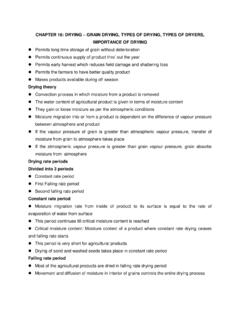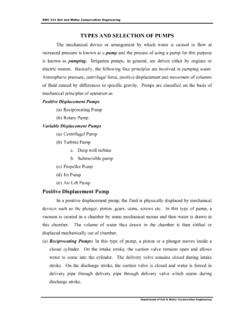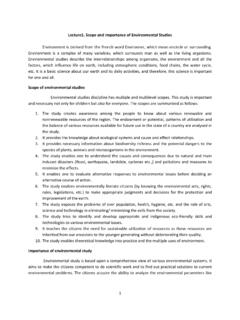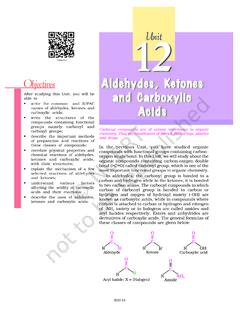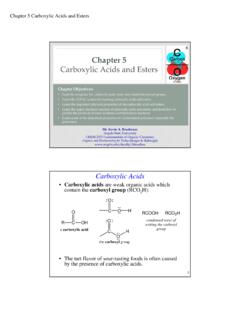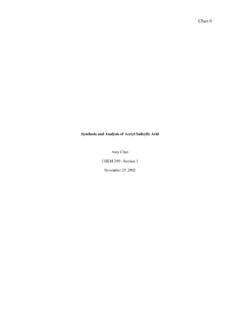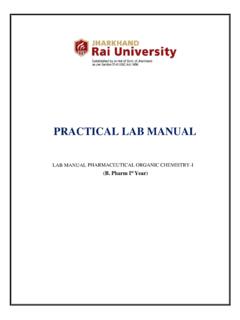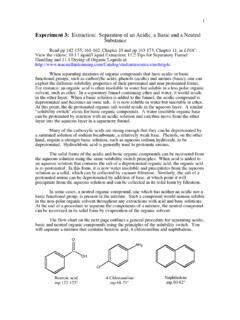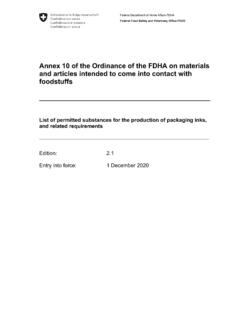Transcription of PRINCIPLES OF PRESERVATION - eagri.org
1 PRINCIPLES OF PRESERVATION PRINCIPLES of Food PRESERVATION A good method of food PRESERVATION is one that slows down or prevents altogether the action of the agents of spoilage. Also, during the process of food PRESERVATION , the food should not be damaged. In order to achieve this, certain basic methods were applied on different types of foods. For example in earlier days, in very cold weather condition, ice was used to preserve foods. Thus, very low temperature became an efficient method for preventing food spoilage.
2 Let us now list the PRINCIPLES of food PRESERVATION . 1. Removal of micro-organisms or inactivating them: This is done by removing air, water (moisture), lowering or increasing temperature, increasing the concentration of salt or sugar or acid in foods. If you want to preserve green leafy vegetables, you have to remove the water from the leaves so that micro organisms cannot survive. You do this by drying the green leaves till all the moisture evaporates. 2. Inactivating enzymes: Enzymes found in foods can be inactivated by changing their conditions such as temperature and moisture, when you preserve peas, one of the methods of preservations is to put them for a few minutes in boiling water.
3 This method also known as blanching inactivates enzymes and thus, helps in preserving the food. 3. Removal of insects, worms and rats: By storing foods in dry, air tight containers the insects, worms or rats are prevented from destroying it. Control Control of microorganisms Heat Cold Drying Acids Sugar and salt Oxygen concentration Smoke Radiation Chemicals (preservatives) Control of enzymes Heat Oxygen removal Acids Chemicals (antioxidants) Control of Other factors Protective packaging Sanitation PRESERVATION methods 1.
4 Thermal processing Application of heat Inactivate enzymes Kill microorganisms. Most bacteria are killed in the range 82-93 c. Spores are not destroyed even by boiling water at 100 c for 30 min. o To ensure sterility (total microbial destruction, including spores), a temperature of 121 c must be maintained for 15 min or longer. Various methods are - a. Blanching b. Pasteurization c. Sterilization d. Boiling e. Steam under pressure 2. Removal of heat (cold processing) Lowering temperature of food Decreases the rate of enzymatic, chemical and microbial reactions in food Storage life is extended Various methods are - a.
5 Refrigeration b. Freezing 3. Control of water content (drying) Microorganisms require free water Free water is removed from the food and therefore, is unavailable to microbial cells Multiplication will stop Water unavailable for chemical/biochemical reactions Storage life extended Various methods are - a. Freezing b. Physical removal of water from food (dehydration) c. Removal of some of the water from food (concentration) d. Addition of substances that bind water in food, making it unavailable (sugar, salts) 4.
6 Radiation Ionizing radiation Inactivate microorganisms in food Destroy storage pests Inactivate enzymes Various methods are - a. Infrared radiation b. Ultraviolet radiation 5. Atmosphere composition Removal of oxygen Inhibits o2-dependant enzymatic and chemical reactions Inhibits growth of aerobic microorganisms Various methods are - a. Paraffin wax b. Nitrogen backflushed bags (potato chips) c. Controlled atmosphere storage d. Vacuum packaging of fresh food (cured meats) 6. Fermentation Specific microorganisms are used (starter cultures) Facilitate desirable chemical changes Longer storage life Produce acids, alcohol that will prevent growth of undesirable microorganisms Produce antimicrobial substances 2.
7 Addition of chemicals Various chemicals used are - a. Acids (inhibit microbial growth and enzymatic reactions) b. Organic acids (acetic, citric, tartaric acids) c. Inorganic acids (hydrochloric, phosphoric acids) d. Food grade, comply w/regulations e. Antioxidants (to delay oxidative rancidity) f. Antimicrobial agents: o sodium propionate (mould inhibitor) o sodium benzoate (antibacterial) o sugar and salt (high concentrations) 8. Smoke Contains preservative chemicals (eg. formaldehyde) from the burning wood Heat also helps destroy microorganisms Heat dries the food 9.
8 Curing (Salt and Sugar) Salt binds with water molecules and thus acts as a dehydrating agent in foods. Impair the conditions under which pathogens cannot survive. Curing is used with certain fruits and vegetables. ( sauerkraut, pickles), Meats can be submerged in a salt solution known as brine PRESERVATION BY USING CHEMICALS A preservative is defined as only substance which is capable of inhibiting, retarding or arresting the growth of microorganisms. Microbial spoilage of food products is also controlled by using chemical preservatives.
9 The inhibitory action of preservatives is due to their interfering with the mechanism of cell division, permeability of cell membrane and activity of enzymes. Pasteurized squashes, cordials and crushes have a cooked flavour. After the container is opened, they ferment and spoil within a short period, particularly in a tropical climate. To avoid this, it is necessary to use chemical preservatives. Chemically preserved squashes and crushes can be kept for a fairly long time even after opening the seal of the bottle.
10 It is however, essential that the use of chemicals is properly controlled, as their indiscriminate use is likely to be harmful. The preservative used should not be injurious to health and should be non-irritant. It should be easy to detect and estimate. Two important chemical preservatives are permitted to beverages according to the FPO (1955). 1. Sulphur dioxide and 2. benzoic acid SULPHUR DIOXIDE It is widely used throughout the world in the PRESERVATION of juice, pulp, nectar, squash, crush, cordial and other products.


